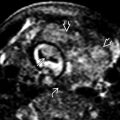KEY FACTS
Imaging
- •
Polydactyly
- ○
1 or more extra digits or parts of digits
- ○
May be preaxial (thumb side) or postaxial (pinky side)
- ○
Nonsyndromal: May be isolated or familial
- ○
Syndromal: Common feature in multiple syndromes
- ○
Diabetes increases risk of preaxial polydactyly
- ○
Important feature of trisomy 13
- ○
- •
Syndactyly
- ○
Fusion of 1 or more digits; very easy to miss
- ○
Can be isolated but more often part of syndrome
- ○
Syndromic case may be extensive (mitten syndactyly)
- ○
Triploidy has characteristic fusion of 3rd and 4th digits
- ○
- •
Clenched hand
- ○
Trisomy 18; look for overriding 2nd finger
- ○
Feature of neuromuscular disorders (e.g., arthrogryposis)
- ○
- •
Clinodactyly
- ○
Radial deviation of distal 5th finger
- ○
2-4% of normal fetuses have clinodactyly
- ○
Minor marker for trisomy 21
- ○
- •
Split hand/foot malformation (ectrodactyly)
- ○
Lobster claw deformity: Old term that should no longer be used
- ○
Deep median cleft with missing central phalanges and metacarpals/metatarsals with fusion of remaining digits
- ○
Creates deep cleft in midhand/foot
- ○
May involve only 1 or both hands/feet
- ○
Scanning Tips
- •
Easy to both under and over diagnose
- •
Use 3D ultrasound to aid in diagnosis
- •
Feet are also affected in many of these conditions but are harder to evaluate
- ○
Be suspicious of polydactyly when foot appears too wide
- ○
- •
Seldom isolated abnormality; carefully scan for other findings that would point to specific syndrome
 is noted with a small extra digit. An obvious bone is not seen. Postaxial polydactyly is one of the most common features in trisomy 13, in addition to severe brain, eye, cardiac, and genitourinary abnormalities.
is noted with a small extra digit. An obvious bone is not seen. Postaxial polydactyly is one of the most common features in trisomy 13, in addition to severe brain, eye, cardiac, and genitourinary abnormalities.
 attached to the 5th finger. This stillborn also had trisomy 13.
attached to the 5th finger. This stillborn also had trisomy 13.
 . Isolated polydactyly is usually autosomal dominant with variable penetrance. Family history is key to making the diagnosis.
. Isolated polydactyly is usually autosomal dominant with variable penetrance. Family history is key to making the diagnosis.
Stay updated, free articles. Join our Telegram channel

Full access? Get Clinical Tree








